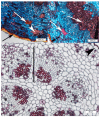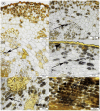Distinctive Traits of European Mistletoe (Viscum album spp. austriacum) and Its Impact on Host Tree Wood (Pinus sylvestris)
- PMID: 40431054
- PMCID: PMC12114866
- DOI: 10.3390/plants14101489
Distinctive Traits of European Mistletoe (Viscum album spp. austriacum) and Its Impact on Host Tree Wood (Pinus sylvestris)
Abstract
European mistletoe is a hemi-parasitic plant increasingly infesting forests in Central Europe, causing premature tree death, and is anticipated to expand its range due to global warming. This study aimed to describe the unique anatomical features of mistletoe and examine the morpho-anatomical response of pine trees to infestation. Anatomical analyses were conducted on mistletoe internodes and the branch wood of affected pines. The findings revealed that mistletoe infestation triggers callose deposition in the cell walls of pine tracheids, a defense mechanism that restricts water flow to the mistletoe. Unique structural features of mistletoe were also identified, including structural dimorphism with the inner system forming only vessels and parenchyma cells, in contrast to the outer system, composed of protective, ground, and conductive tissues, and which displays an uneven distribution of chlorophyll and starch grains along the plant axis. Additionally, starch and chlorophyll were present in the parenchyma cells of the haustorium. Starch presence there may potentially enable internal photosynthesis, and the compounds formed after starch hydrolysis may facilitate water uptake from the host's xylem sap. These results provide new insights into the anatomical adaptations of mistletoe and the defensive responses of pine trees, contributing to a deeper understanding of host-parasite interactions in forest ecosystems.
Keywords: callose; forest dieback; parasite–host interaction; structural dimorphism; wood.
Conflict of interest statement
The authors declare no conflicts of interest. The funders had no role in the design of the study; in the collection, analyses, or interpretation of data; in the writing of the manuscript; or in the decision to publish the results.
Figures






Similar articles
-
Mistletoe infestation mediates alteration of the phytohormone profile and anti-oxidative metabolism in bark and wood of its host Pinus sylvestris.Tree Physiol. 2017 May 1;37(5):676-691. doi: 10.1093/treephys/tpx006. Tree Physiol. 2017. PMID: 28338758
-
Effects of mistletoe removal on growth, N and C reserves, and carbon and oxygen isotope composition in Scots pine hosts.Tree Physiol. 2016 May;36(5):562-75. doi: 10.1093/treephys/tpw024. Epub 2016 Apr 15. Tree Physiol. 2016. PMID: 27083524 Free PMC article.
-
Mistletoe Versus Host Pine: Does Increased Parasite Load Alter the Host Chemical Profile?J Chem Ecol. 2019 Jan;45(1):95-105. doi: 10.1007/s10886-018-1039-9. Epub 2018 Dec 7. J Chem Ecol. 2019. PMID: 30523519
-
Phytochemical profile and therapeutic potential of Viscum album L.Nat Prod Res. 2016;30(4):373-85. doi: 10.1080/14786419.2015.1022776. Epub 2015 Mar 27. Nat Prod Res. 2016. PMID: 25813519 Review.
-
The cardioprotective potential of selected species of mistletoe.Front Pharmacol. 2024 Apr 11;15:1395658. doi: 10.3389/fphar.2024.1395658. eCollection 2024. Front Pharmacol. 2024. PMID: 38666019 Free PMC article. Review.
References
-
- Tulik M. The Anatomical Traits of Trunk Wood and Their Relevance to Oak (Quercus robur L.) Vitality. Eur. J. Forest Res. 2014;133:845–855. doi: 10.1007/s10342-014-0801-y. - DOI
-
- Venturas M., López R., Martín J.A., Gascó A., Gil L. Heritability of Ulmus minor Resistance to Dutch Elm Disease and Its Relationship to Vessel Size, but Not to Xylem Vulnerability to Drought. Plant Pathol. 2014;63:500–509. doi: 10.1111/ppa.12115. - DOI
-
- Tsopelas P., Angelopoulos A., Economou A., Soulioti N. Mistletoe (Viscum album) in the Fir Forest of Mount Parnis, Greece. For. Ecol. Manag. 2004;202:59–65. doi: 10.1016/j.foreco.2004.06.032. - DOI
LinkOut - more resources
Full Text Sources
Miscellaneous

